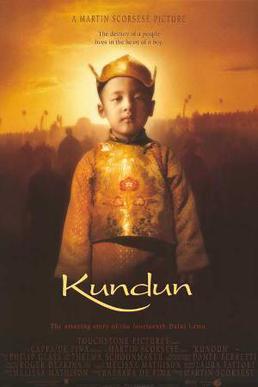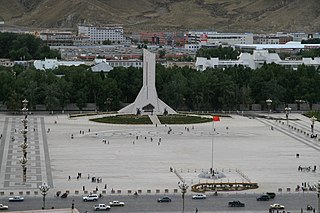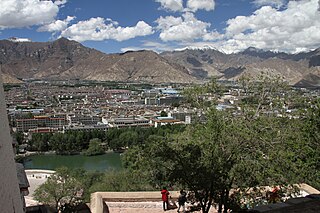Related Research Articles


The Tibet Autonomous Region or Xizang Autonomous Region, often shortened to Tibet or Xizang, is a province-level autonomous region of the People's Republic of China in Southwest China. It was overlayed on the traditional Tibetan regions of Ü-Tsang and Kham.

Lhasa is the urban center of the prefecture-level Lhasa City and the administrative capital of Tibet Autonomous Region in southwest China. The inner urban area of Lhasa City is equivalent to the administrative borders of Chengguan District, which is part of the wider prefectural Lhasa City.

Cui Jian is a Beijing-based Chinese singer-songwriter, trumpeter and guitarist. Affectionately called "Old Cui", he is credited with pioneering Chinese rock music. For this distinction he is often labeled the "Father of Chinese Rock".

Chinese rock is a wide variety of rock and roll music made by rock bands and solo artists from Mainland China. Typically, Chinese rock is a fusion of forms integrating Western popular music and traditional Chinese music.

The music of Tibet reflects the cultural heritage of the trans-Himalayan region centered in Tibet, but also known wherever ethnic Tibetan groups are found in Nepal, Bhutan, India and further abroad. The religious music of Tibet reflects the profound influence of Tibetan Buddhism on the culture.

Kundun is a 1997 American epic biographical film written by Melissa Mathison and directed by Martin Scorsese. It is based on the life and writings of Tenzin Gyatso, the 14th Dalai Lama, the exiled political and spiritual leader of Tibet. Tenzin Thuthob Tsarong, a grandnephew of the Dalai Lama, stars as the adult Dalai Lama, while Tencho Gyalpo, a niece of the Dalai Lama, appears as the Dalai Lama's mother.

Tibet developed a distinct culture due to its geographic and climatic conditions. While influenced by neighboring cultures from China, India, and Nepal, the Himalayan region's remoteness and inaccessibility have preserved distinct local influences, and stimulated the development of its distinct culture.
Miss Tibet is an annual beauty pageant held in McLeod Ganj, India. It is produced by Lobsang Wangyal Productions.

GyutoTantric University is one of the great monastic institutions of the Gelug Order.

Dreaming Lhasa is a Tibetan-language film by veteran documentary filmmakers, Ritu Sarin and Tenzing Sonam, who have been making films about various aspects of Tibet under the banner of White Crane Films since 1990. Written by Tenzing, a first-generation Tibetan born and brought up in exile, Dreaming Lhasa is perhaps, the first Tibetan feature film to explore the state of exile and the issues of identity, culture and politics as they affect the Tibetan refugee community in India.

Namling County is a county of Shigatse in the Tibet Autonomous Region.
Gyêgu Subdistrict, formerly a part of the Gyêgu or Jiegu town is a township-level division in Yushu, Yushu TAP, Qinghai, China. The name Gyêgu is still a common name for the Yushu city proper, which include Gyêgu subdistrict and three other subdistricts evolved from the former Gyêgu town. The four subdistricts altogether forms a modern town which developed from the old Tibetan trade mart called Jyekundo or Gyêgumdo in Tibetan and most Western sources. The town is also referred to as Yushu, synonymous with the prefecture of Yushu and the city of Yushu.

Sinicization of Tibet includes the programs and laws of the Chinese government and the Chinese Communist Party (CCP) which force "cultural unity" in Tibetan areas of China, including the Tibet Autonomous Region and surrounding Tibetan-designated autonomous areas. The efforts are undertaken by China in order to remake Tibetan culture into mainstream Chinese culture.
The 1987–1989 Tibetan unrest was a series of protests and demonstrations that called for Tibetan independence. These protests took place between September 1987 and March 1989 in the Tibet Autonomous Region, in the Tibetan regions of Sichuan, and Qinghai, as well as the Tibetan prefectures in Yunnan and Gansu. Protests began shortly after the Dalai Lama, the religious and temporal leader of Tibet exiled in India since the 1959 Tibetan unrest, proposed a Five Point Peace Plan regarding the “status of Tibet” on September 21, 1987, which was subsequently rejected by the Chinese government. The Plan advocated for greater respect and autonomy of the Tibetan people, and claimed that “Tibet was a fully independent state when the People’s Liberation Army invaded the country in 1949-50.” China rejected the idea of Tibetans as an invaded people, stating that “Tibet is an inalienable part of Chinese territory” and has been for hundreds of years. The Tibetan sovereignty debate is longstanding, and the Tibetan assertion that they are a separate and unique people invaded by China has become a central argument for their independence.

The main religion in Tibet has been Buddhism since its outspread in the 8th century AD. As of 2022 the historical region of Tibet is mostly comprised in the Tibet Autonomous Region (TAR) of China and partly in the Chinese provinces of Qinghai and Sichuan. Before the arrival of Buddhism, the main religion among Tibetans was an indigenous shamanic and animistic religion, Bon, which would later influence the formation of Tibetan Buddhism and still attracts the allegiance of a sizeable minority of Tibetans.

Rock 'N' Roll on the New Long March is a 1989 album by Cui Jian, the so-called "Father of Chinese Rock". It is technically his second album as an album called Return of the Prodigal was released in 1984 in Hong Kong and Taiwan only, but he considers it his first and does not acknowledge the previous one. It is Cui's most successful album, and is considered China's first rock album. It also features "Nothing to My Name", the song that made Cui famous and which is considered to mark the beginning of rock music in China. Cui made the album in cooperation with the band ADO, and it was the only album he released while he was still with them.

There is widespread belief in ghosts in Tibetan culture. Ghosts are explicitly recognized in the Tibetan Buddhist religion as they were in Indian Buddhism, occupying a distinct but overlapping world to the human one, and feature in many traditional legends. When a human dies, after a period of uncertainty they may enter the ghost world. A hungry ghost has a tiny throat and huge stomach, and so can never be satisfied. Ghosts may be killed with a ritual dagger or caught in a spirit trap and burnt, thus releasing them to be reborn. Ghosts may also be exorcised, and an annual festival is held throughout Tibet for this purpose.
Dadon, name Dadon Dawa Dolma is a Tibetan singer and actress.

Lhasa is a prefecture-level city, one of the main administrative divisions of the Tibet Autonomous Region of China. It covers an area of 29,274 square kilometres (11,303 sq mi) of rugged and sparsely populated terrain. Its urban center is Lhasa, with around 300,000 residents, which mostly corresponds with the administrative Chengguan District, while its suburbs extend into Doilungdêqên District and Dagzê District. The consolidated prefecture-level city contains additional five, mostly rural, counties.
References
- ↑ "Vajara" seems to be the English name that the band itself prefers in its promotional material. See the eponymous album covers: cover
- 1 2 3 4 5 6 7 Erlich, Reese (2009-05-05). "Rock 'N' Roll At The Top Of The World". NPR. Retrieved 2013-03-16.
- 1 2 3 4 Joy (2005-10-05). "Tibetan band rocks Beijing". China Tibet Information Center. Retrieved 2013-03-16.
- 1 2 Li, Litchi (2007-02-14). "Tibetan rock band Tianchu issues new album". China Tibet Information Center. Retrieved 2013-03-16.
- 1 2 3 4 5 6 Erlich, Reese (2008-08-18). "Young Tibetans plug in to rock - within limits". San Francisco Chronicle. Retrieved 2013-03-16.
- 1 2 3 "Young Tibetans infuse new vigor into Tibetan culture". Beijing: Xinhuanet. 2009-03-27. Archived from the original on April 12, 2013. Retrieved 2013-03-16.
- 1 2 3 4 Zhang, Rui (2006-03-17). "The Rising Sounds of Tibetan Music". China Internet Information Center. Retrieved 2013-03-16.
- 1 2 Cai, Champ (2012-12-21). "Tianchu: Tibet's first local rock band". China Tibet Online. Retrieved 2013-03-16.
- ↑ "Tian Chu, the rock band on the highest altitude". China Tibet Information Center. 2004-12-04. Retrieved 2013-03-16.
- ↑ "Tibetan Rock Band Obtains Financial Supporter". China's Tibet Magazine. 2008-03-12.